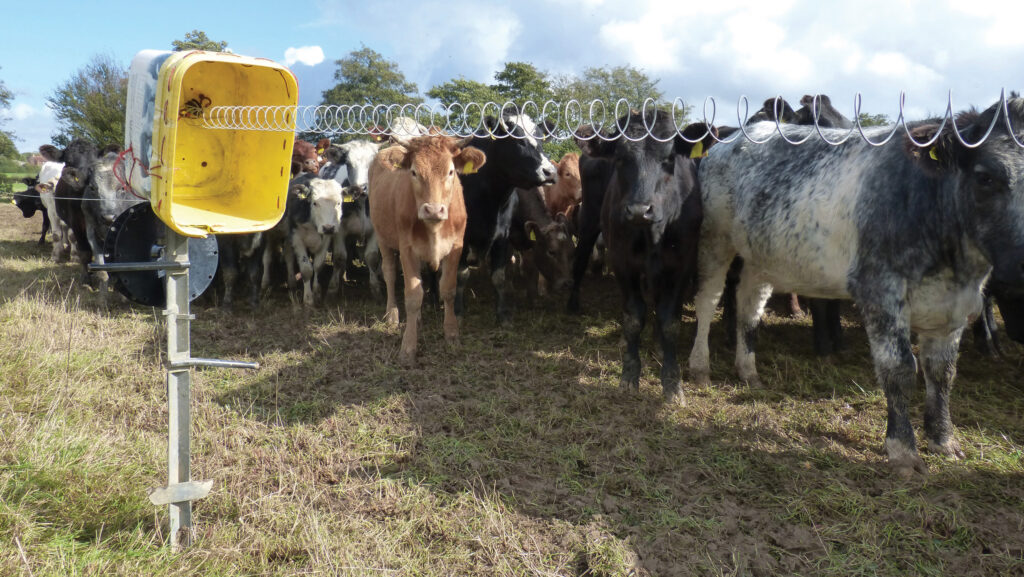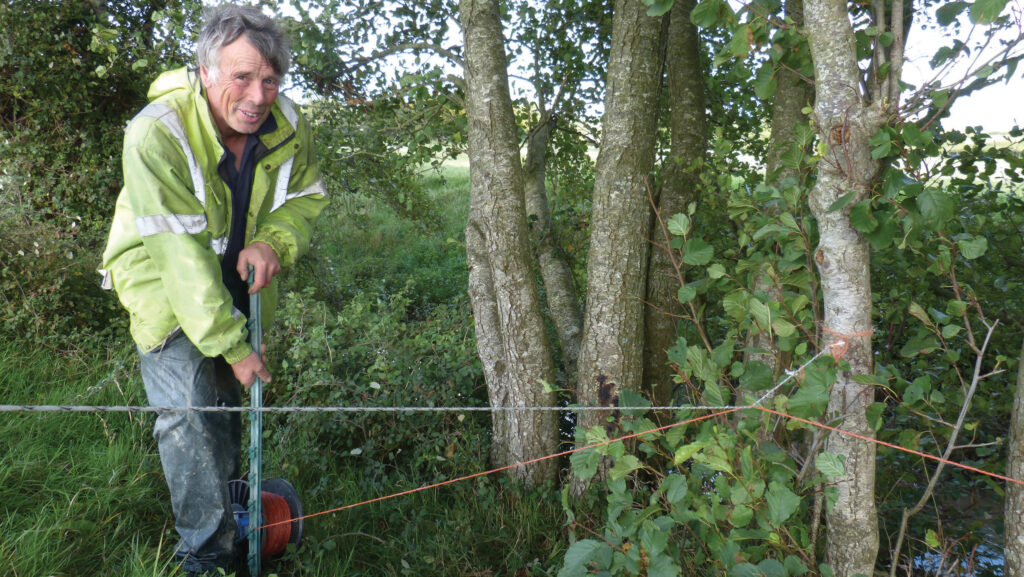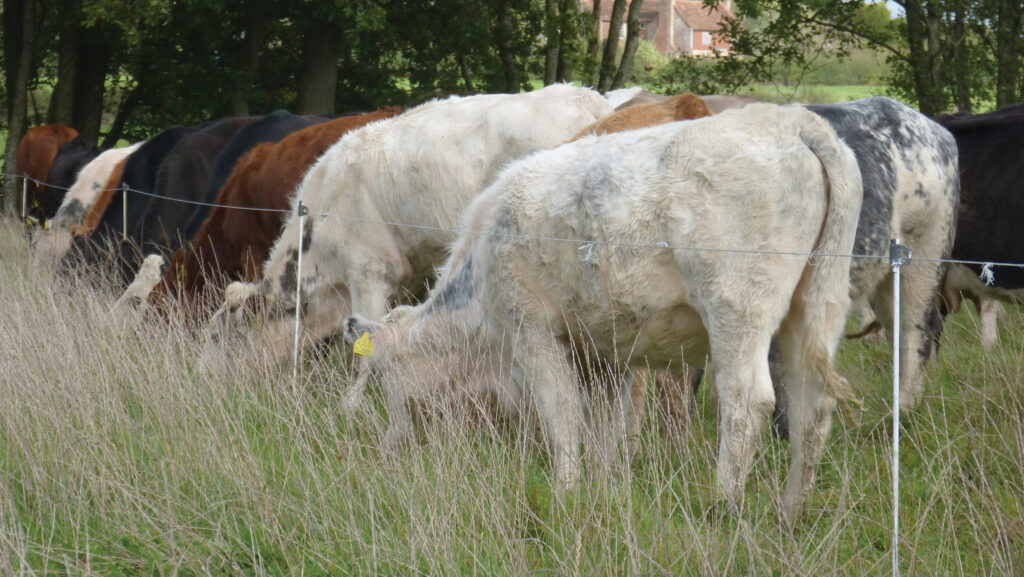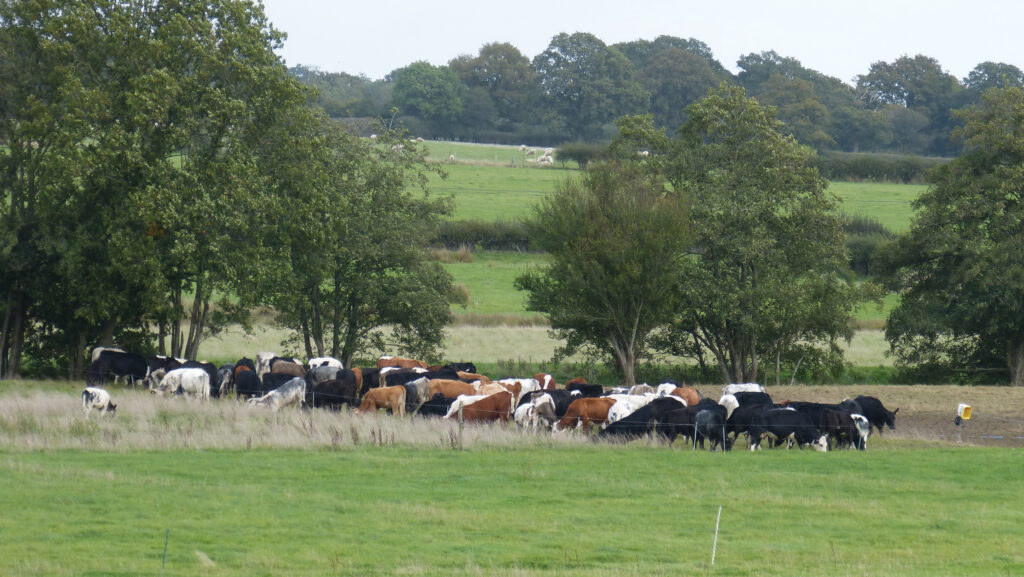Moving cattle four times a day keeps cost under £350 a cow
 © MAG/Michael Priestley
© MAG/Michael Priestley Maximising grassland periods by moving cattle up to four times a day has reduced winter housing from five months to as little as seven weeks on a heavy clay Kent farm.
This has controlled costs on David Cornforth’s suckler beef operation at Lomas Farm, Sandhurst, which produces forward (450-500kg) stores for Ashford market.
Output averages 40 stores a year from a system running very close to 1 livestock unit (LSU)/ha with no synthetic fertiliser.
See also: What is ‘Total grazing’ and will it work in the UK?
About 44 livestock units graze 47ha (116 acres). This has been achieved on Weald clays, with one-third of the farm on marshy flood plain next to the River Hexden.
Lomas Farm cacts

David Cornforth © MAG/Michael Priestley
- 47ha grassland
- Flying herd of 45 suckler cows
- Stocking up to 130 head of cattle in the summer
- Selling 40 strong stores at Ashford market annually
- Flying herd calving over four months from March
Achieving four moves a day
No hard and fast rules apply on the size of the grazing block, or the duration the animals are left on it.
Generally, rotations are at least 40 days and stock are on no piece of ground longer than 12 hours.
David achieves multiple daily moves in the following way:
- Subdivision Fields are split into 30-40m-wide channels with a strainer post 20m into the field. Each channel is subdivided into breaks as small as 0.1ha (0.25 acre). Cattle graze one channel completely before moving onto the next.
- Electricity Mains power reaches every field on the farm. David carries a voltmeter everywhere he goes, checking the fence is at 5,000 volts or more.
- Perimeter fencing Each field (average size 5ha (12 acres)) has a perimeter fence connected to mains electricity, to which wires are hooked to create small paddocks.
- Water Supply from a well sunk in 2019 has eliminated utility charges. Every paddock has a 25mm water line mole-ploughed to it with a hydrant every 150m.
- Automation Four automatic gate units are set on timers to minimise labour requirement for moving fences.
- Adaptability An extra break can be added if the weather changes and heavy rain is forecast. Conversely, animals can be given smaller areas in dry conditions when utilisation rates are higher.
- Simplicity Calves are weaned at spring turnout and mob-graze, with yearlings and calved cows joining them as they calve. Cattle graze in one mob for nine months a year. Dry cows graze nearer the house on daily shifts until they calve.
- Breeding An electrified fencing rod is used to separate a bulling cow from the rest of the herd. The cow is then walked to the farm for serving with high-index, easy-calving Angus, Limousin and British Blue semen.
- Animal impact Running cattle in a single group maximises saliva, excretions, and passing of rumen bacteria onto exposed soil below, feeding the land.

© MAG/Michael Priestley
System change
David’s system evolved out of a necessity to pay the mortgage. He and wife Jane, a librarian, bought Lomas Farm – a working dairy farm – for £390,000 in 1996.
David had been an electrician on North Sea oil rigs in the 1980s and then farmed with his brother Robin in his native North Yorkshire.
David took out a £100,000 mortgage to buy Lomas Farm and had £370,000-worth of milk quota. But the farm made a loss, and the mortgage grew to £140,000 with 10% interest and 95 cows.
He got out of dairying in 2002. “My problem was I wasn’t working with nature; I thought the answer was in a bag.”
Close to breaking point, he rented out Lomas Farm and took Jane and their four children to New Zealand to help run a dairy near Methven.
On his return in 2004, he worked full-time as an electrician, rewiring houses.
Farming friend Fergus Henderson suggested David buy thin cows out of Ashford market as a low-cost way back into farming livestock.
This is the basis for his flying herd of crossbreds today.
Initially, however, David was disheartened by the effects of his set stocking. He only had 12 cows, but needed to house them for five months.
“I call it the rabbit factor,” he says. “Rabbits don’t eat a lot of grass, but they can stop a lot of grass from growing, and that’s what I was doing by spreading my cows out.”
Not to be beaten, he researched rotational and mob grazing, drawing on the experience of farmers who had turned their fortunes around by resting ground and promoting root development.
He and Fergus attended AHDB grazing meetings run by Liz Genever and read books such as The Carbon Fields by Graham Harvey.
In 2009, David started experimenting with rotational grazing. To save money he fashioned fence posts out of trees found on the farm using a chainsaw.
Inspiration was drawn from videos of the late Neil Dennis singlehandedly moving up to 1,000-head eight times a day, and latterly Allen Williams and Jaime Elizondo.

© MAG/Michael Priestley
Improvements
Slowly, soil health improved. The herd grew to 45 cows. Longer rest periods between grazing encouraged deeper roots to develop, feeding a greater microbial and increase fungal activity.
This year one 10ha area with lightly poached areas has been rested for 12 months to recover.
The productivity benefits of the change in grazing management have been:
- Three months saved on winter haylage feeding – housing is now in December instead of September
- Shortening housing period, from 150 days to as low as 45 days
- Drought resilience: the farm got through five months of drought in 2022 without selling stock or buying in feed
- No vaccines, wormers, synthetic fertiliser or cereal are purchased
Costs in a typical year |
||
|
Item |
Cost, averaged annually (£) |
Comment |
|
Hay/haylage |
3,220 |
140 bales at £23 a bale on average |
|
Pre-calving mineral buckets |
192 |
Six tubs at £32 each |
|
Contracting |
2,500 |
4-5ha (10-12 acres) of big bale silage; muck spreading and hedge cutting |
|
Caesarean section |
37.50 |
One C-section every eight years |
|
New Forest Eye treatment |
24.33 |
Cost of one pack of antibiotics treatment spread over three years |
|
Miscellaneous antibiotics |
60 |
Three bottles of alamycin for foul in the foot |
|
Haulage |
525 |
Three loads at £175 a load (store cattle and cull cows share a truck) |
|
Diesel |
840 |
1,200 litres at 70p/litre for spreading/mixing compost and placing/feeding bales |
|
Artificial insemination |
840 |
£300 on liquid nitrogen for the flask and 70 straws at £12/straw |
|
Fencing gear |
300 |
Renewing automatic fence release systems and reels with Precision Grazing |
|
Replacement cows |
5,500 |
Buy in seven cows for £1,250 and sell five culls at £650 = £5,500 net |
|
New bale grab |
76 |
Cost £1,900 over 25 years |
|
Loader maintenance |
300 |
Servicing and replacing hoses (in-house) |
|
Loader depreciation |
80 |
£16,000 written off over 20 years. Bought for £10,000, £1,000 for tyres, £5,000 for major repairs including gear box |
|
Total |
14,494.83 |
£322 a cow |
|
||
